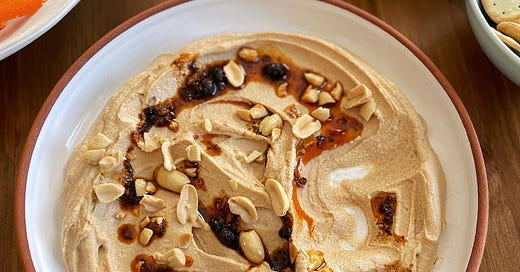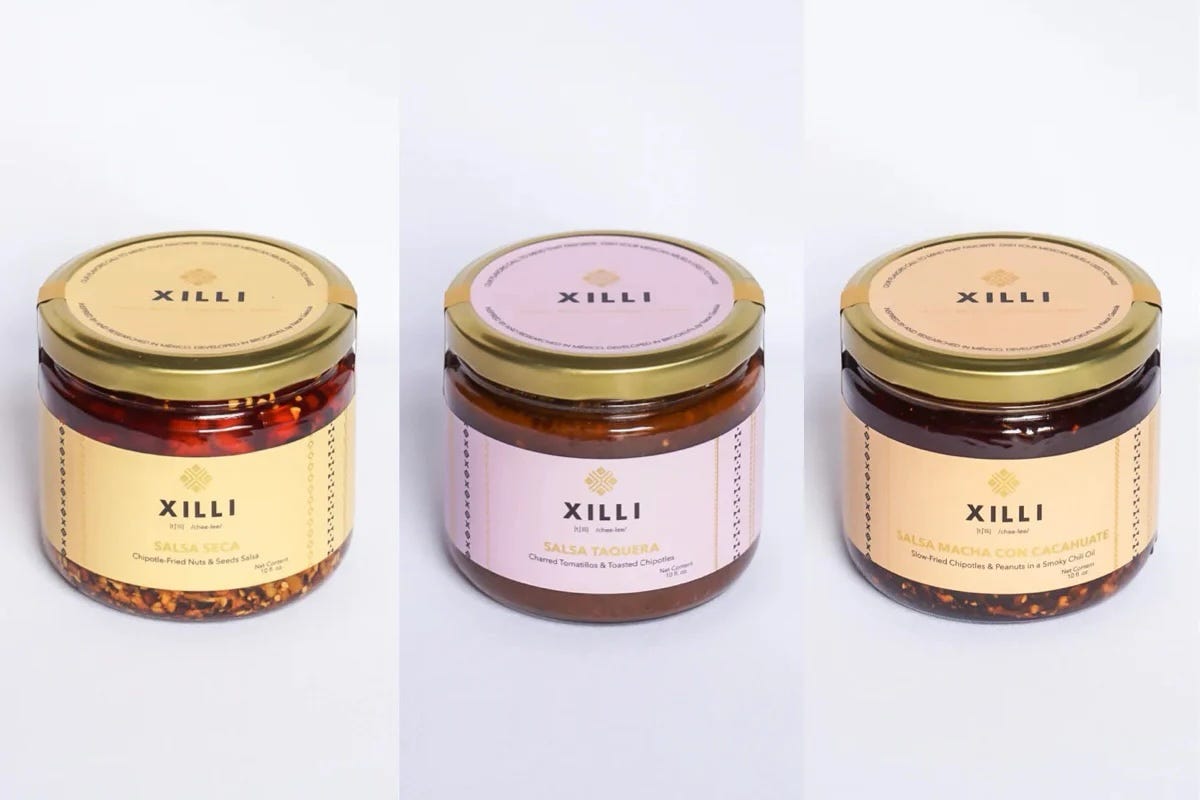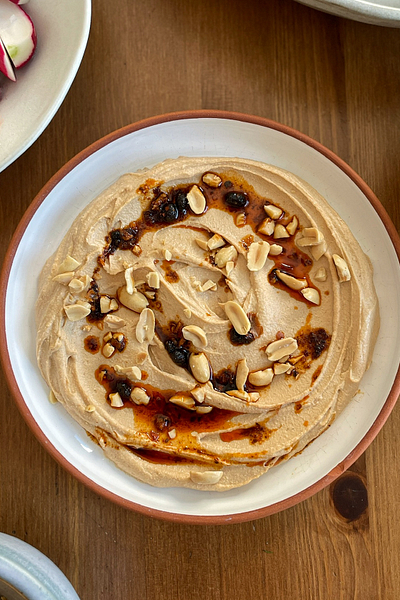The Spicy-Sweet Peanut Butter Dip I Can't Stop Making
Plus chatting with Chef Nacxi Gaxiola of XILLI, to understand the impact of tariffs on his acclaimed salsa company
My tips for minimal-mess dinner parties — and the general urge to gather around the table lately — seems to have struck a chord, and so today I’m very happy to follow up white a recipe to further encourage you to invite people over. I’ve made this dip for three gatherings lately, and don’t plan to slow down anytime soon.
You could call it a high-protein dip, which is a clue as to what the secret ingredient is (okay, it’s tofu), but that sells its utter deliciousness short. Smeared on a plate, it has a whipped, rich consistency that sits like cloudy meringue on a celery stick, plus surprise personality in the form of some sweetness and spiciness. Most people first think it’s hummus, and then they’re delighted to discover that it’s not.
It is also a perfect vehicle for a spicy, nubby, and aromatic oil-based drizzle such as salsa macha or chili crisp, spooned over just before serving. And with one of my favorites being the salsa macha from XILLI, I thought it would be a good opportunity to have a short Q&A with its founder, Nacxi Gaxiola. With all the frantic developments around tariffs, it can be easy to overlook the small food businesses that are left with their futures uncertain, and I was curious to hear how they have impacted XILLI so far.
Many of these businesses are not big money makers, but rather mission-driven enterprises with a quest to share, preserve, and cultivate respect for the culinary traditions that their founders connect to and love. Yet I see their impact as so significant — a critical part of culinary boom that’s evolved over the past many decades, and directly shaping our globally oriented pantries.
You can find my Q&A with Nacxi below, and my recipe down further.
Q&A with Chef Nacxi Gaxiola of XILLI
XILLI is a salsa company created in 2014, and was the first to make salsa macha commercially available in the United States. Its founder Nacxi Gaxiola is a chef and culinary consultant who has spent the past 20 years studying authentic cuisine and exploring it through modern techniques.
Could you tell us a little about your salsas and why you originally decided to create XILLI?
I’m a chef by trade, originally from Mexico, and I also spent about five years researching traditional Mexican cuisine. While still working in the restaurant industry in NYC, it was hard for me to comprehend the lack of quality and, more importantly, authenticity when it came to Mexican food in the U.S. (at least at the time). It was also frustrating to see that even the packaged products coming from Mexico — supposedly representing our culture — weren’t much better in terms of quality. At the same time, I was looking for a project that could better reach more people, without having to open a restaurant in every city (maybe one day I will though).
Did you have any time to prepare for the tariffs? How will they impact your bottom line and operations?
Of course not. Specifically because there has been so much uncertainty from the start. One day they're being implementing, the next they're being postponed, over and over again. It’s basically like “Schrödinger’s” Tariffs. This makes it nearly impossible to plan or prepare for something so unpredictable.
For example, one of our latest imported shipments landed exactly during the two days when the tariffs on Mexican goods were implemented. As a result, we have had to absorb that additional cost but can’t reasonably justify it in our shelf price, because, in essence, those tariffs are not currently in effect. This represents a sunk cost we must bear due to the lack of clarity and consistency in policy.
As for our bottom line and operations, we’ll have to wait and see. Our main concern is that the tariffs seen across the board will reduce overall purchasing power. As a brand of high-end products, we are concerned that the general population will hold off on buying these kinds of products for the time being, especially if prices need to increase.
We already have a hard time “explaining” why our products are priced the way they are, even when we are completely confident that our products are of the highest quality on the market. We sometimes say we are twice the price of similar offerings, but 3 to 10 times better in quality, so from a quality-to-price perspective, we still believe we offer the best deal in town. :)
That said, when there is still a large portion of the population that is not familiar with the types of products we make, and in general, many still struggle to understand why they should pay more for a product that, in their view, was never high quality to begin with (like chips and salsa, for example).
On the customer side, are there any misconceptions about small businesses such as yours, and how you'll be affected?
I do believe that the bulk of our customers will understand — or at least I hope they will. What I find interesting is that many people believe only products made in Mexico, like ours, will be affected by these changes. What they don't realize is that a significant portion of raw materials and ingredients still come from Mexico—even for products that aren't traditionally considered Mexican.
In that sense, I believe all Mexican-inspired products — including those from our competitors — will be affected. The same goes for many other non-Mexican products. For example, I assume that for many Italian tomato sauces on the market, a decent portion of their plum tomatoes comes from Mexico. Honestly, I highly doubt they’re bringing fresh tomatoes from Italy. This will also be the case for almost anyone using tomatoes, tomatillos, and a variety of fresh or dried chiles. These tariffs, if fully implemented, will likely ripple across a wide range of products and categories, well beyond just “Mexican” food.
What can we do to support you right now?
I wish I knew. Right now, we’re feeling pretty disheartened because we were in the middle of conversations related to fundraising that would have helped us sustain and expand our operations to keep up with growth and demand. However, given the current uncertainty, these conversations have stalled.
On the other hand, with people unsure about where the economy is headed, we’re noticing a shift in spending habits — or at least this seems to be the case regarding anything beyond basic pantry essentials, including products like ours.
Our current hope lies in what’s known as the “lipstick effect” — the idea that in tough economic times, people still tend to spend on small, affordable luxuries. We hope that our products can fill that role for some customers. You might not be willing to splurge on a visit to Cosme, for example, but hopefully, we can bring you the same quality in a jar.
Something else I want to mention is that, as a Green Card holder, my concerns go beyond just the tariffs. Immigration policy and uncertainty around travel also weigh heavily on us. For instance, we had several exciting developments in the pipeline that are now on hold, simply because there’s fear surrounding travel and the possibility of not being allowed to return.
For more information about Chef Nacxi and XILLI, and to order XILLI salsa macha, visit the XILLI website.
Spicy, Fluffy Peanut Butter Dip
Yield 2 cups | Prep time 10 minutes
8 ounces extra-firm tofu, drained (about half a block)
½ cup (128g) natural unsalted peanut butter
4 teaspoons (14g) coconut sugar or brown sugar
3 to 4 teaspoons (9-12g) sriracha, or another spicy chili sauce, to taste
Juice of 2 limes (3 tablespoons)
½ teaspoon fine sea salt (or to taste if using salted peanut butter)
3 to 6 tablespoons warm water
Crushed, roasted peanuts, for garnish
Your favorite salsa macha or chili crisp, for garnish (XILLI Salsa Macha and KariKari are two favorites of mine)
1. Break the tofu into large pieces and put them into the bowl of a food processor. Add the peanut butter, sugar, sriracha, lime juice, and salt. Process until the mixture is relatively smooth.
2. With the motor running, add the warm water 1 to 2 tablespoons at a time, until the dip takes on a whipped, frosting-like consistency. Scrape the sides periodically to ensure all the peanut butter gets incorporated, and process for a few minutes to achieve a completely smooth texture.
3. To serve, swoop the dip over a shallow bowl or plate. Spoon chili crisp over the top, using your judgment as to how much to use, and then sprinkle the peanuts on top. Use as a dip for cut-up vegetables, crackers, or spread it over toast or tuck it into your favorite veggie sandwiches.









This sounds amazing. Also: If you’ve never tried the whipped tofu /cashew butter / broccoli situation from Alexa Weibel on NYT cooking, I highly recommend.
Been waiting for this dip my entire LIFE.